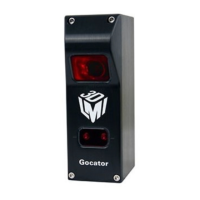Gocator 2300 & 2880 Series
Gocator Web Interface • Scan Setup and Alignment • 92
Setting Description
Uniform Spacing (Data Resampling) on page 46.
Analog
Analog camera gain can be used when the application is severely exposure limited, yet
dynamic range is not a critical factor.
Digital
Digital camera gain can be used when the application is severely exposure limited, yet
dynamic range is not a critical factor.
Sensitivity
Controls the exposure that dynamic exposure converges to. The lower the value, the
lower the exposure Gocator will settle on.
The trade-off is between the number of exposure spots and the possibility of over-
exposing.
Threshold
The minimum number of spots for dynamic exposure to consider the spot valid. If the
number of spots is below this threshold, the algorithm will walk over the allowed
exposure range slowly to find the correct exposure.
To configure material:
1. Go to the Scan page.
2. Expand the Sensor panel by clicking on the panel header or the button.
3. Click the button corresponding to the sensor you want to configure.
The button is labeled Top, Bottom, Top-Left, or Top-Right, depending on the system.
Materials can be configured separately for each sensor.
4. Click on the Materials tab.
5. Choose a material in the Materials drop-down or choose Custom to manually configure settings.
See the table above for the customizable settings.
6. Save the job in the Toolbar by clicking the Save button .
7. Check that laser profiling is satisfactory.
After adjusting the setting, confirm that laser profiling is satisfactory.
Various settings can affect how the Material settings behave. You can use Video mode to examine how
the settings interact. See Spots and Dropouts on page 110 for more information.
Alignment
Gocator sensors are pre-calibrated and ready to deliver profiles in engineering units (mm) out of the box.
However, alignment procedures are required to compensate for sensor mounting inaccuracies, to align
multiple sensors into a common coordinate system, and to determine the resolution (with encoder) and
speed of the transport system. Alignment is performed using the Alignment panel on the Scan page.
Once alignment has been completed, the derived transformation values will be displayed under
Transformations in the Sensor panel; see Transformations on page 83 for details.
Alignment States
A Gocator can be in one of three alignment states: None, Manual, or Auto.

